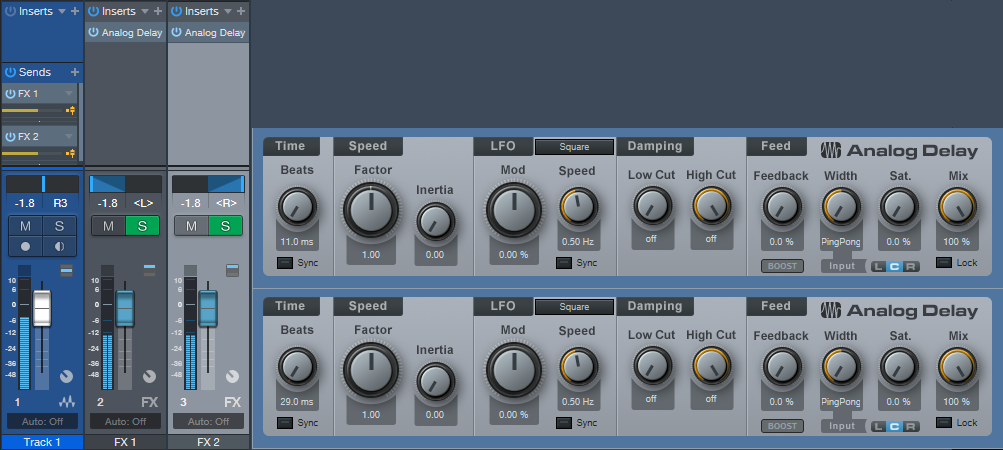Widen Your Mono Guitar—Sans Problems
Your guitar is most likely mono. But sometimes you want a wide, full, stereo image. I can relate.
One technique is to send the guitar track to an FX channel, insert a delay set for a relatively short delay (like 25 ms), and then pan the original track and FX channel oppositely. But if you sum the signals to mono, then there’s the possibility of cancellation. In fact, I saw a guy in an internet video who said this was a terrible idea, and you should just overdub the part again and pan that oppositely if you want stereo.
Well, overdubbing is an option, assuming you can play tightly enough that the parts don’t sound sloppy. But don’t forget Studio One has that wonderful Channel Mode button on the Main output, so you can test stereo tracks in mono—simply adjust the delay time for minimum cancellation. You won’t be able to avoid cancellation entirely, but tweaking the time may keep it from being objectionable (especially once the delay time gets above 25 ms or so, because that’s more into doubling range). To make any phase issues even less noticeable, lower the delayed sound’s level a little bit to weight the sound more toward the dry guitar.
But I wouldn’t be writing this tip if I didn’t have a better option—so here it is.
- Pan your main guitar track to center.
- Send it to two FX Channels.
- Insert an Analog Delay in each channel, with Mix set for 100% delay, Factor to 1.00, Mod to 0.00, and Width fully counterclockwise. Pan them oppositely. Set the damping as desired. The screenshot shows a good starting point for your settings.
- Set different delay times, preferably somewhat far apart, for the two delays. I prefer prime number delays (3, 5, 7, 11, 13, 17, 19, 23, 29, 31, 37, 41 ms) so the delay timings don’t interfere with each other. For example, set one delay to 11 ms, and the other to 29 ms.
- Bring up the levels of the two delayed channel to create a pleasing stereo spread. It won’t be as dramatic a spread as using one dry and one delayed sound panned oppositely…but frankly, that “super stereo” effect sounds gimmicky compared to a full, robust stereo image. However, if you do want a more dramatic stereo separation, drop the center channel guitar by 6 dB in relation to the FX Channels that are panned right and left—you’ll still get most of the benefits of this approach. (You may need to group all three channels, and raise their levels a bit to compensate for the drop from lowering the center channel level.)
Now, here’s where the magic happens. Set the Main output mode to mono, and you’ll hear virtually no difference between that and the “faux stereo” signal, other than the stereo imaging. The reason why is that now, we have a guitar in the center channel—so choosing mono creates a center channel buildup. This raises the main guitar’s level above the delayed sounds, so there’s virtually no chance of audible cancellation, and it balances the level better between the stereo and mono modes.
Now you have a wide guitar that sounds equally loud, and is phase-issue free, in mono or stereo—happy Friday!
